

* Direct all correspondence to Neil J. MacKinnon, Professor, Department of Sociology and Anthropology, University of Guelph, Guelph, Ontario, Canada N1G2W1
E-mail:
Telephone: (519) 824-4120 (Extension 3941)
FAX: (519) 837-9561
Past research has provided invaluable information on physician attitudes towards active euthanasia, physician-assisted suicide, and withholding or withdrawing treatment to terminally-ill patients. However, studies to date have often been descriptive or, when explanatory, have tested limited (bivariate) hypotheses or have employed single equation (ordinary least squares or logistic regression) models to identify predictors of physician attitudes. In contrast, the exploratory study reported in this paper proposes and estimates a multiple equation causal model. This model specifies the subjective likelihood of engaging in active euthanasia, physician-assisted suicide, and withholding treatment as the outcome of a social psychological process involving religiosity, the personal moral and legal attitudes of physicians, and their moral assessment of hypothetical acts of intervention by another physician. Our data is derived from an anonymous mail survey of all physicians (excluding dermatologists, ear-nose-throat specialists, gynecologists, and pediatricians) in a medium-size Southern Ontario city (N=51; response rate=50.5%). Employing ordinary least squares multiple regression, we estimated the causal model separately for active euthanasia, physician-assisted suicide, and withholding treatment to terminally-ill patients. In addition, we conducted an analysis of effects to decompose the total causal effects of variables on subjective likelihood into direct and indirect effects. Findings reveal that two parallel social psychological processes influence the subjective likelihood of intervening in the dying process: (1) an evaluative, affective process involving moral considerations; (2) a more cognitive, rational one involving legal considerations. In general, religiosity affects only the first of these two processes, but the moral influence of religiosity varies by type of intervention. The analysis of effects reveals that moral attitude has the largest total causal effect on the subjective likelihood of engaging in active euthanasia and physician-assisted suicide, followed by religiosity, legal attitude, and the moral assessment of the act. In the case of withholding treatment, a large total effect for moral attitude is found along with a small total effect for the moral assessment of the act. The model explains 47% of the variance in the subjective likelihood of engaging in active euthanasia; 74%, in physician-assisted suicide; and 75%, in withholding treatment.
Key Words: euthanasia, physician-assisted suicide, withholding treatment, physician attitudes.
In the wake of a number of highly publicized cases of euthanasia and physician-assisted suicide in Canada, the United States, and elsewhere1 , a burgeoning literature emerged in the 1990s as the medical profession, the field of bioethics, and legislatures alike wrestled with the moral, legal, and policy implications of physician interventions in the dying process2 . While an empirical literature also accumulated during this time, the number of published studies pales by comparison. In addition to three studies of physician attitudes conducted in the Netherlands (Van der Maas, van Delden, Pijnenborg, and Looman 1991), a 1995 review of international research (Chochinov and Wilson 1995) identified only ten studies in English-speaking countries — five in the U.S., one in England, three in Australia, and one in Canada. Since this review was published , however, the empirical literature has grown substantially, including studies conducted in the U.S. (Bachman, Alcser, Doukas, Lichtenstein, Corning, and Brody 1996; Back, Wallace, Starks, and Pearlman 1996; Curry, Schwartz, Gruman, and Blank 2000; Emanuel, Fairclough, Daniels, and Clarridge 1996; Emanuel, Fairclough, Clarridge, Blum, Bruera, Penley, Schnipper, and Mayer 2000; Ganzini, Fenn, Lee, Heintz, and Bloom 1996; Lee, Nelson, Tilden, Ganzini, Schmidt, and Tolle 1996; Meier, Emmons, Wallenstein, Quill, Morrison, and Cassel 1998; Wolfe, Fairclough, Clarridge, Daniels, and Emanuel 1999), the United Kingdom (Dickinson, Lancaster, Clark, Ahmedzai, and Noble 2002), and non-English speaking countries such as Finland (Hinkka, Kosunen, Metsanoja, Lammi, and Kellokumpu-Lehtinen 2002; Ryynanen, Myllykangas, Viren, and Heino 2002 ). In Canada, where the study reported here was conducted, our review of the literature netted only three studies to date — two Alberta provincial surveys (Kinsella and Verhoef 1993a, 1993b; Suarez-Almazor, Belzile, and Bruera 1997) and a small qualitative study of a Toronto teaching hospital (Kelner and Bourgeault 1993).
Past research has found consistently that physicians are less disposed than the general public to agree with the morality or legalization of active euthanasia and physician-assisted suicide, but that the profession is deeply divided (Back et al. 1996; Chochinov & Wilson 1995; Curry et al. 2000; Kinsella and Verhoef 1993a; Lee et al. 1996; Emanuel et al. 1996; Suarez-Almazor et al.1997). There is evidence, however, that physician attitudes towards withholding or withdrawing treatment are less negative than those towards active euthanasia and physician-assisted suicide (Kelner and Bourgeault 1993; Cook, Guyatt, Jaeschke, Reeve, Spanier, King, Molloy, Willan, and Streiner 1995; Ryyanen et al. 2002). While the effects of sex, age, and other individual characteristics on physician attitudes are inconsistent across studies (Chochinov and Wilson 1995; Emmanuel et al. 2000; Dickenson et al. 2002; Kinsella and Verhoef 1993a; Suarez-Almazor et al.1997; Kelner and Bourgeault 1993), religious affiliation and/or religiosity (strength of religious beliefs or frequency of practice) have been found consistently to have an important influence on physician attitudes (Chochinov and Wilson 1995; Curry et al. 2000; Emmanuel et al. 2000; Kinsella and Verhoef 1993a; Suarez-Almazor et al. 1997; Kelner and Bourgeault 1993). Research has also shown that physician attitudes towards intervening in the dying process are related to the medical circumstances of the patient (Chochinov and Wilson 1995; Suarez-Almazur et al. 1997; Kelner and Bourgeault 1993; Cook et al. 1995). Finally, a number of studies have investigated whether some of the variation in physician attitudes can be explained by medical speciality (Hinkka et al. 2002; Dickenson et al. 2002; Kinsella and Verhoef 1993a; Suarez-Almazur et al. 1997; Kelner and Bourgeault 1993), but findings from these studies are not easily compared because of inconsistent classifications of medical speciality across studies. There is some evidence, however, that palliative care physicians (Chater, Viola, Paterson, and Jarvis 1998; cf Suarez-Almazor et al. 1997) and those who feel adequately trained in end-of-life care (Emmanuel et al. 2000) are less inclined than other physicians to endorse or engage in radical interventions in the dying process.
While past studies have provided a great deal of invaluable information on physician attitudes towards intervening in the dying process, they have often been descriptive or, when explanatory, have tested limited (bivariate) hypotheses or have employed single equation (ordinary least squares or logistic regression) models to identify predictors of physician attitudes. In contrast, the study reported in this paper, to our knowledge, is the first to propose and estimate a multiple equation causal model. Specifically, this model specifies the subjective likelihood of engaging in active euthanasia, physician-assisted suicide, and withholding treatment as the outcome of a social psychological process involving religiosity, moral and legal attitudes, and the moral assessment of hypothetical acts of intervention described in realistic scenarios. Despite the sampling limitations of this exploratory study, its findings should prove informative to future Canadian and international research conducted with larger probability samples.
The hypothetical scenarios employed in this study (see Appendix) make it clear that an attending physician is engaging in a voluntary act from the perspective of a competent patient (Senate of Canada 1995). Thus, for the purposes of this study, active euthanasia refers to a physician complying with the wishes of a competent patient by performing an act (e.g., a lethal injection) that results in her or his death; physician-assisted suicide, by providing the means (e.g., prescription drugs) by which a competent patient may end his or her own life; and withholding treatment, by acceding to the request of a competent patient to withhold life-sustaining treatment.
The legal status of these interventions varies both across and within countries. For instance, physicians in the Netherlands have been protected from persecution for about two decades provided they adhere to certain guidelines. On the other hand, legislation was passed to legalize euthanasia and physician-assisted suicide in the Northern Territory, Australia, then revoked. In the United States, where a Supreme Court decision left the legalization of euthanasia and physician-assisted suicide to individual states, Oregon passed the Death with Dignity Act in 1997 legalizing physician-assisted suicide. Active euthanasia and physician-assisted suicide are illegal under Canadian law, while withholding treatment is legal as long as the physician has not initiated treatment (Greenspan and Rosenberg 1999).3
The study reported in this paper estimates the general causal model illustrated in Figure 1 separately for active euthanasia, physician-assisted suicide, and withholding of treatment to terminally-ill patients. The model consists of three exogenous (input) variables — X1 (sex), X2 (year of graduation from medical school, a surrogate measure of age), and X3 (religiosity, the frequency of attendance at religious services) — and four endogenous variables — Y1 (moral attitude), Y2 (legal attitude), Y3 (moral assessment of a hypothetical act by another physician), and Y4 (the subjective likelihood of personally engaging in the act). The measurement of these constructs is described below. Variables are ordered causally from left to right in the model. Although we allowed for all possible effects in preliminary estimation of the model for each type of intervention, we hypothesized in advance that only specific direct and indirect effects would be substantiated. Hypothesized direct effects are denoted by causal arrows in Figure 1 and indirect effects can be identified by interconnecting variables along causal paths.
Figure 1: Causal Model for Active Euthanasia, Physician-Assisted Suicide, and Withholding Treatmenta
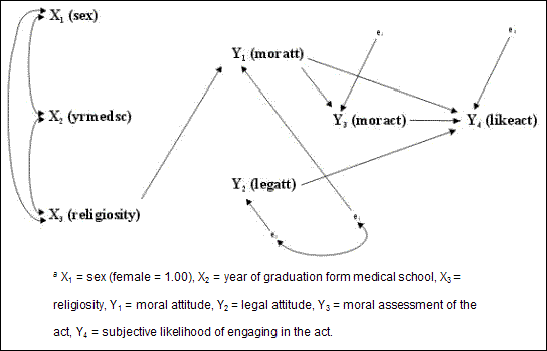
Because the influence of religion on physician attitudes has already been well-established, we hypothesized that religiosity (X3) would have a direct effect on moral attitude (Y1), as well as indirect effects via moral attitude (Y1) on the moral assessment of the act (Y3) and the subjective likelihood of personally engaging in a similar act (Y4). Because of inconsistent findings in the literature, we did not hypothesize that sex (X1) or year of graduation from medical school (X2), a surrogate measure of age, would directly affect moral (Y1) or legal (Y2) attitudes, but allowed for the possibility of these effects in preliminary estimation of the model for each type of intervention.
The absence of a causal arrow between religiosity (X3) and legal attitude (Y2) in Figure 1 represents our assumption that the legal attitudes of physicians result more from cognitive, rational considerations of the legal consequences of an act of intervention than from religious convictions. Based on the related assumption that the effects of legal attitudes, in turn, are independent of moral considerations, we hypothesized that legal attitude (Y2) directly affects the subjective likelihood of engaging in an act (Y4), unmediated by the moral assessment of the act itself (Y3).
While the causal model proposed in this paper is based on our review and understanding of the empirical literature on physician interventions in the dying process, it also has a theoretical basis in attitude theory and research in social psychology. For instance, our hypotheses that moral (Y1) and legal (Y2) attitudes directly affect the subjective likelihood of engaging in an act (Y4) parallels the attitude-to-intention component of the classic model of attitudes proposed by Fishbein and Ajzen (1975). However, we also hypothesized that moral attitude (Y1) indirectly affects subjective likelihood (Y4) via the moral assessment of hypothetical acts of intervention by another physician described in realistic scenarios (Y3). The rational for the Y1 to Y3 component of this indirect effect is based on the supposition that personal moral attitudes (Y1) should influence the moral assessment of hypothetical acts of intervention by another physician (Y3). The rationale for the Y3 to Y4 component of the indirect effect of Y1 on Y4 is less obvious. Here, we reason that the concreteness and salience introduced into the respondent=s task of morally assessing hypothetical acts of intervention by another physician by depicting these acts in realistic scenarios (Y3) should directly affect respondents= expressed likelihood of personally engaging in these practices (Y4). Put differently, asking respondents to morally assess the hypothetical acts of another physician (Y3) introduces a normative component in our model, specified as a constraint on behavioral intentions in the Fishbein-Ajzen (1975) model of attitudes. That is, to the extent that one=s moral assessment of the actions of others (Y3) is culturally based, it should normatively constrain own=s own intentions as well — here, the subjective likelihood of engaging in one or another intervention in the dying process (Y4).
Following convention, we denote causally unanalyzed correlations among exogenous variables (X1, X2, and X3) by curved double-headed arrows. Also following convention, we specify an unanalyzed correlation between the endogenous variables, moral attitude (Y1) and legal attitude (Y2), by a curved double-headed arrow between the error terms (e1 and e2) for these variables. Mathematically, a model specifying reciprocal effects between Y1 and Y2 would be under-identified because of insufficient information (a lack of instrumental variables), hence un-estimable (Asher 1983). Moreover, for the purposes of this paper, we were less interested in the causal relation between moral and legal attitudes than in their causal antecedents and effects in the model.
The target population for this study comprised all physicians (except for dermatologists, ear-nose-throat specialists, gynecologists, and pediatricians) in a medium-size Southern Ontario city. In effect, we targeted 100% of the physicians in the community who are most likely to encounter situations of intervening in the dying process. To minimize costs, we accessed this population by delivering anonymous, self-administered surveys to the mailboxes of physicians at the city=s general hospital in late February, 2000. Virtually all physicians in this community held hospital privileges at the time of this study. By April 13, 2000, the cut-off date for the return of surveys, we received 51 of the 101 surveys distributed, a response rate of 51.5%. We did not conduct a follow-up mailing because of time constraints and because we did not believe that it would enhance sample size beyond a few additional cases. The description of the sample is reported in Table 1. Judging from statistical information obtained from the Ontario Medical Association, the sample is reasonably representative of the target population of physicians in terms of sex and age.
In view of the anticipated difficulty of obtaining data on a sensitive topic from “this typically difficult to reach population” (Curry et al. 2000: 357-358), we consider our response rate of 50.5 % a surprisingly good one, in line with a number of other published studies. For instance, a survey of 7228 Connecticut physicians resulted in a response rate of 39.6%, and only 32% of these respondents provided data for a qualitative analysis (Curry et al. 2000). Another survey of 6642 U.S. oncologists with a follow-up mailing yielded a response rate of only 39.8%, which was enhanced to 51.5% by means of telephone contacts and additional mailings for a randomly selected subsample of 1273 (Emmanuel et al. 2000). The response rate for a convenience sample of 372 medical staff and 105 resident physicians produced a response rate of 47% (Bushwick, Emphrain, and Peters 2000). While the response rate in a number of other studies is higher than the studies cited — e.g., 69% (Kinsella and Verhoef 1993a), 73% (Suarez-Almazor et al. 1997), Hinkka et al. (2002:112) describe their return of 62% for a survey of Finnish physicians as “higher than the average for surveys among doctors.” Finally, while our sample size is less than optimal, other studies with small samples have contributed to our knowledge of physician attitudes and practices — e.g., 59 physicians (Chater et al. 1998); 20 physicians (Kelner and Bourgeault 1993). In any case, our survey yielded a sufficient number of respondents to estimate the causal model proposed in this paper.
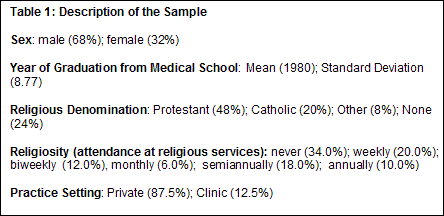
The survey provided functional definitions of active euthanasia, physician-assisted suicide, and withholding treatment followed, in turn, by hypothetical scenarios depicting an attending physician engaging in each act (see Appendix). The use of scenarios or vignettes in this area of research has been found to be an effective method by other researchers (e.g., Cook et al. 1995; Hinkka et al. 2000; Ryyanen et al. 2002; Wolfe et al. 1999; see Curry et al. 2000 for additional references). Each scenario was followed by five questions. The first asked respondents to assess the morality of the act portrayed in the hypothetical scenario on a semantic differential rating scale ranging from (1) immoral to (7) moral. This provided the measure of the moral assessment of the act (Y3) in our model. The second and third questions, respectively, asked respondents to indicate how they would personally feel morally and legally about making the decision described in the hypothetical scenario, employing a rating scale ranging from (1) uncomfortable to (7) comfortable. These two questions provided the measures of moral (Y1) and legal (Y2) attitudes in our model. The fourth question asked respondents to estimate the likelihood that they would make the decision if they were the attending physician in the hypothetical scenario, employing a rating scale ranging from (1) unlikely to (7) likely. This provided the measure of the subjective likelihood of personally engaging in the act (Y4). The final question asked physicians if they had ever encountered a similar situation in their professional practice.
We did not employ a measure of the actual behavior of physicians for two reasons. First, asking physicians if they have personally engaged in active euthanasia or physician-assisted suicide might have proved threatening or offensive, resulting in a low response rate. Second, judging from past research, the percentage of physicians who have engaged in euthanasia or physician-assisted suicide is very low, a lifetime participation rate of about only 5% for physician-assisted suicide (Back et al. 1996; Meier et al. 1998). In a study of U.S. oncologists (Emmanual et al. 2000), 3.7% reported ever practicing euthanasia; 10.8%, physician-assisted suicide. Therefore, we decided that the only practical way to incorporate a behavioral variable into our small study at all was to employ a measure of the subjective likelihood that a physician would engage in these practices. Finally, because this study was conducted in a relatively small city, we did not collect additional background information on physicians (e.g., actual age, medical specialty) in order to protect their anonymity and enhance response rate.
We employed ordinary least squares multiple regression to estimate the causal model for each kind of intervention. In each case, we conducted preliminary analyses that allowed for all possible effects between antecedent and later variables in the model (whether hypothesized or not), deleted insignificant effects, and re-estimated the model. Although random sampling was not employed in this study, we used tests of significance as a heuristic device to distinguish trivial from possibly important effects, employing the marginal significance level of .10 as a general guideline for the deletion of effects. In this regard, we chose to err in the direction of Type I rather than Type II error because substantively important effects would otherwise have been deleted as a consequence of small sample size. Finally, we conducted an analysis of effects (Pedhazur 1997) employing LISREL equations (Joreskog & Sorbom 1986) to decompose the total causal effects of independent variables into their direct and indirect4 effects on the subjective likelihood (Y4) of engaging in each type of intervention in the dying process.
Considerations of space preclude reporting the correlations among variables and preliminary regression analyses. These can be obtained from the senior author.
The estimation of the causal model for active euthanasia, physician-assisted suicide, and withholding treatment is presented in Figures 2-4, respectively. In addition, Tables 2-4 report the direct, indirect, and total causal effects of exogenous (X1, X2, X3) and prior endogenous (Y1, Y2, Y3) variables on the subjective likelihood of engaging in each type of intervention (Y4). Standardized regression coefficients are reported because their range of -1.00 to 1.00 facilitates interpretation, enabling one to assess the relative effects of causally prior variables on later variables in a model.
Figure 2: Causal Model for Active Euthanasiaa
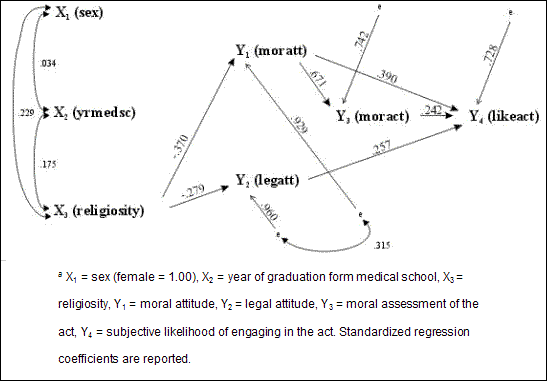
Figure 3: Causal Model for Physician-Assisted Suicidea
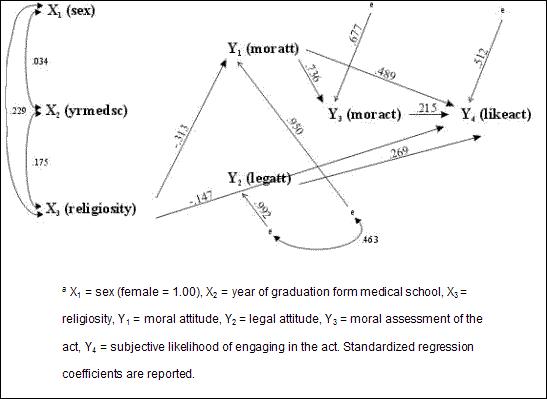
Figure 4: Causal Model for Withholding Treatmenta
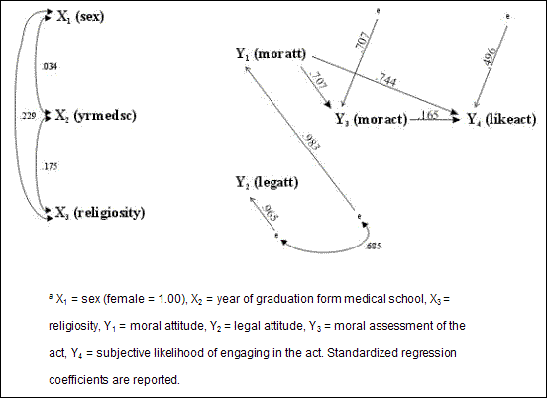
Referring to Figures 2-4, neither sex (X1) nor year of graduation from medical school (X2) directly affects any of the endogenous variables in the three models. Religiosity (X3), however, directly affects the moral attitudes (Y1) of physicians towards active euthanasia (-.370) and physician-assisted suicide (-.313), but has no effect on moral attitude (Y1) towards withholding treatment. As reported in Tables 2 and 3, religiosity (X3) indirectly affects the subjective likelihood (Y4) of engaging in active euthanasia (-.276) and physician-assisted suicide (-.203). In the case of active euthanasia, this indirect effect occurs via both moral (Y1) and legal (Y2) attitudes; in the case of physician-assisted suicide, via moral attitude (Y1) only, as hypothesized by our causal model. In addition, religiosity indirectly affects the moral assessment of the act (Y3) for both active euthanasia (-.248) and physician-assisted suicide
(-.230). All these direct and indirect effects are negative, indicating that religiosity has a dampening effect on moral and/or legal attitudes towards active euthanasia and physician-assisted suicide, the moral assessment of these acts performed by another physician, and the subjective likelihood of personally engaging in these practices. Finally, the unpredicted direct effects of religiosity (X3) on legal attitude (Y2) toward active euthanasia (-.279) and on the subjective likelihood (Y4) of engaging in physician-assisted suicide (-.147) will be discussed below.
Referring to Figure 2 and Table 2, moral attitude (Y1) towards active euthanasia directly affects the moral assessment of the act (Y3) (.671) and the subjective likelihood of engaging in the practice (Y4) (.390); moral attitude (Y1) also has an indirect effect (.162) on subjective likelihood (Y4) via the moral assessment of the act (Y3); and both legal attitude (Y2) and the moral assessment of the act (Y3) have direct effects (.257 and .242, respectively) on subjective likelihood (Y4). All these effects are consistent with the proposed causal model (Figure 1). Mutatis mutandis, the same pattern of effects occurs for physician-assisted suicide (Figure 3 and Table 3) and withholding treatment (Figure 4 and Table 4) with one exception — legal attitude (Y2) does not affect the subjective likelihood of withholding treatment (Y4). As discussed below, this can be attributed to the fact that almost all physicians reported feeling legally comfortable with this practice.
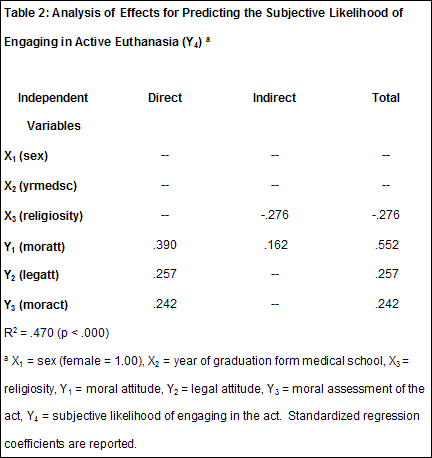
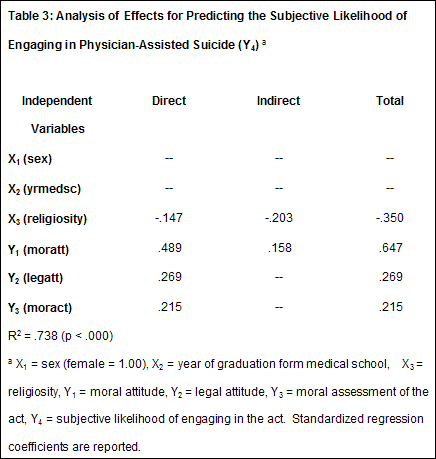
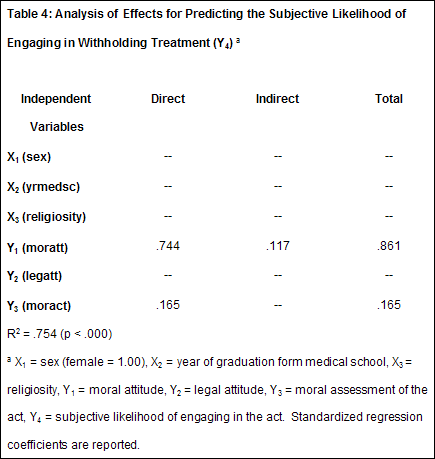
The relative causal effects of variables on the subjective likelihood of engaging in each kind of intervention (Y4) can be assessed by referring to the total effects reported in Tables 2-4. In the case of active euthanasia and physician-assisted suicide, moral attitude (Y1) has the largest total effect on subjective likelihood (Y4), followed by religiosity (X3), legal attitude (Y2), and the moral assessment of the act (Y3). In the case of withholding treatment, moral attitude (Y1) has a very large total effect followed by a small effect for the moral assessment of the act (Y3). The large total causal effects of moral attitude (Y1) on subjective likelihood (Y4) (.552 for active euthanasia, .647 for physician-assisted suicide, and .861 for withholding treatment) reveal that the subjective likelihood of a physician engaging in each type of intervention is largely a consequence of moral conviction. The negative total causal effect of religiosity (X3) on active euthanasia (-.276) and physician-assisted suicide (-.350) illustrate its overall dampening effect on the subjective likelihood (Y4) of engaging in these practices. By the same token, the absence of a total causal effect for religiosity (X3) on the subjective likelihood (Y4) of withdrawing treatment suggests that this more passive type of intervention lies outside the purview of religious proscriptions. Finally, the RSQ values in Tables 2-4 indicate that the causal model explains a sizable proportion of variance in the subjective likelihood (Y4) of engaging in each type of intervention — 47% for active euthanasia, 74% for physician-assisted suicide, and 75% for withholding treatment.
The pattern of effects among endogenous variables suggests that two parallel social psychological processes influence the subjective likelihood of engaging in an act of active euthanasia, physician-assisted suicide, or withholding treatment. The first can be termed a moral one, consisting of the direct effect of moral attitude (Y1) on the subjective likelihood of engaging in the act (Y4) and an indirect effect via the moral assessment of the act involving another physician (Y3); the second, a legal one, consisting of the direct effect of legal attitude (Y2) on the subjective likelihood of engaging in the act (Y4). The first process is more affective than cognitive, dominated by moral feelings rather than legal considerations. The second process is more cognitive than affective, dominated by rational considerations of the legal consequences of an intervention rather than its moral implications.
In general, religiosity affects the moral but not the legal process, but the influence of religiosity varies by type of intervention. The fact that religiosity does not affect the moral process in the case of withholding treatment suggests that this practice has become morally acceptable to most physicians independent of their religious convictions. It also suggests that a practice that has become institutionalized as a legally acceptable and largely taken-for-granted medical procedure attenuates the influence of religiosity on moral attitudes towards this practice. In support of these interpretations, 86.3% of physicians in our study reported that they feel morally comfortable in making a decision to withhold treatment (compared to 23.5% for active euthanasia and 31.4% for physician-assisted suicide); 84.3% reported feeling legally comfortable in making the decision to withhold treatment (compared to 2% for active euthanasia and 7.8% for physician-assisted suicide); and 84.3% reported that they have encountered a situation of withholding treatment in their practice (compared to 43.1% for active euthanasia and 30.3% for physician-assisted suicide). The greater confluence of moral (Y1) and (Y2) legal attitudes in the case of withholding treatment compared to other interventions is supported by a correlation of .68, compared to .21 for active euthanasia and .40 for physician-assisted suicide.
Finally, the direct negative effect of religiosity (X3) on the subjective likelihood of engaging in an act of physician-assisted suicide (Y4) suggests that religiosity also has a proscriptive influence that is independent of the moral process described above. Why this occurs for physician-assisted suicide and not active euthanasia is open to speculation. In addition, there seems to be no easy explanation for the unpredicted finding of a direct negative effect of religiosity (X3) on legal attitude (Y2) in the active euthanasia case. However, neither of these effects are very large and may not replicate in larger studies, nor does either appear in more than one of the three empirical models.
In conclusion, the causal model proposed in this exploratory study needs to be re-estimated with large probability samples from other populations. Although we feel confident that our sample is representative of physicians in the community in which we conducted our study, we cannot generalize our findings statistically to the more extensive populations of physicians in Ontario, Canada, or other countries. On the other hand, we can identify no theoretical reasons why our findings should not replicate in provincial or national samples of Canadian physicians, or even national samples from other countries. In this regard, we take encouragement from the fact that an estimation of the causal model for a convenience sample of non-physicians (119 university students) from the same community revealed the same moral and legal social psychological processes identified in our study of physicians. Despite the more hypothetical nature of the task for non-physician respondents and the greater amount of role-taking required of them, differences in findings from physicians were confined to the appearance of minor sex and age effects and variation in the effect of religiosity across type of intervention.
In future research with larger samples, we recommend the inclusion of additional inputs to the model, particularly those which might serve as instrumental variables enabling one to estimate the reciprocal effects between moral and legal attitudes (Asher 1983). Larger samples would also enable one to employ dummy variables (Pedhazur 1997) to incorporate a categorical exogenous variable for medical specialty. This would enable one to contrast the attitudes and intentions of palliative care physicians, oncologists, and others dealing with chronically or terminally ill patients with those of other specialists and general practitioners.
Asher, H.B. 1983. Causal modeling (2nd ed). Beverley Hills (CA): Sage.
Bachman, J.G., K.H. Alcser, D.J. Doukas, R.L. Lichtenstein, A.D. Corning, and H. Brody. 1996. “Attitudes of Michigan Physicians and the Public toward Legalizing Physician-Assisted Suicide and Voluntary Euthanasia.” New England Journal of Medicine 334: 303-309.
Back, A.I., J.I. Wallace, H.E. Starks, and R.A. Pearlman. 1996. “PAS and Euthanasia in Washington State: Patient Requests and Physician Responses.” Journal of the American Medical Association 275: 919-925.
Cassel, C.K. and D.E. Meier. 1990. “Morals and Moralism in the Debate over Euthanasia and Assisted Suicide.” New England Journal of Medicine 323: 750-752.
Chater, S., R. Viola, J. Paterson, and V. Jarvis. 1998. “Sedation for Intractable Distress in the Dying — a Survey of Experts.” Palliative Medicine 12: 255-69.
Chochinov, H.M. and K.G. Wilson. 1995. “The Euthanasia Debate: Attitudes, Practices and Psychiatric Considerations.” Canadian Journal of Psychiatry 40: 593-602.
Cook, D.J., G.H. Guyatt,, R. Jaeschke, J. Reeve, A. Spanier, D. King., D.W. Molloy, A. Willen, and D.L. Streiner. 1995. “Determinants in Canadian Health Care Workers of the Decision to Withdraw Life Support from the Critically Ill. Journal of the American Medical Association 273: 703-8.
Curry, L., H.I. Schwartz, C. Gruman, and K. Blank. 2000. “Physicians’ Voices on Physician-Assisted Suicide: Looking Beyond the Numbers.” Ethics & Behavior 10: 337-361.
Dickinson, G.E., C.J. Lancaster, D. Clark, S.H. Ahmedzai, and W. Noble. 2002. “U.K. Physicians’ Attitudes toward Active Voluntary Euthanasia and Physician-Assisted Suicide.” Death Studies 26: 479-490.
Dunsmuir, M., M. Smith, S. Alter, and S. Harder. 1998. Euthanasia and Assisted Suicide. Ottawa: Supply and Services Canada [cat noYM32-1/91-9-1998-10E].
Emanuel, E.J., D.L. Fairclough, E.R. Daniels, and B.R. Clarridge. 1996. “Euthanasia and Physician-Assisted Suicide: Attitudes and Experiences of Oncology Patients, Oncologists, and the Public.” Lancet 347: 1805-1810.
Emanuel, E.J., D. Fairclough, B.C. Clarridge, D. Blum, E. Bruera, W.C. Penley, L.E. Schnipper, and R.J. Mayer. 2000. “Attitudes and Practices of U.S. Oncologists Regarding Euthanasia and Physician-Assisted Suicide.” Annals of Internal Medicine 133: 527-532.
Fishbein, M. and I. Ajzen. 1975. Belief, Attitude, Intention, and Behavior: an Introduction to Theory and Research. Reading (MA): Addison-Wesley.
Ganzini, L., D.S. Fenn, M.A. Lee, R.T. Heintz, and J.D. Bloom. 1996. “Attitudes of Oregon Psychiatrists Toward Physician-Assisted Suicide.” American Journal of Psychiatry 153: 1469-1475.
Greenspan, E. and M. Rosenberg. 1999. Martin=s Criminal Code, 1999. Aurora (ONT): Canada Law Books.
Hinkka, H., E. Kosunen, R. Metsanoja, U.K. Lammi, and P. Kellokumpu-Lehtinen. 2002. “Factors Affecting Physicians’ Decisions to Forego Life-Sustaining Treatments in Terminal Care.” Journal of Medical Ethics 28: 109-114.
Joreskog, K. and D. Sorbom. 1986. LISREL VI: Analysis of Linear Structural Relations by the Method of Maximum Likelihood. Mooresville (IN): Scientific Software.
Kelner, M.J. and I.L. Bourgeault. 1993. “Patient Control over Dying Responses of Health Care Professionals.” Social Science & Medicine 36: 757-65.
Kinsella,T.D. and M. Verhoef. 1993a. “Alberta Euthanasia Survey:1. Physicians= Opinions about the Morality and Legalization of Active Euthanasia.” Canadian Medical Association Journal 148: 1921-6.
Kinsella,T.D. and M. Verhoef. 1993b. “Alberta Euthanasia Survey: 2. Physicians= Opinions about the Acceptance of Active Euthanasia as a Medical Act and the Reporting of such Practice.” Canadian Medical Association Journal 148: 1929-33.
Lavery, J.V., B.M. Dickens, J.M. Boyle, and P.A. Singer. 1997. “Bioethics for Clinicians: 11. Euthanasia and Assisted Suicide.” Canadian Medical Association Journal 156: 1405-1408.
Lee, M.A., H.D. Nelson, V.P. Tilden, L. Ganzini, T.A. Schmidt, and S.W. Tolle. 1996. “Legalizing Assisted Suicide — Views of Physicians in Oregon.” New England Journal of Medicine 334: 310-315.
Lemmens, T. 1996. “Towards the Right to be Killed? Treatment Refusal, Assisted Suicide and Euthanasia in the United States and Canada.” British Medical Bulletin 52: 341-353.
Lowy, F., D.M. Sawyer, and J.R. Williams. 1993. “Canadian Physicians and Euthanasia: 4. Lessons from Experience.” Canadian Medical Association Journal 148: 1895-9.
Meier, D.E., C.A. Emmons, S. Wallenstein, T. Quill, R.S. Morrison, and C.K. Cassel. 1998. “A National Survey of Physician-Assisted Suicide and Euthanasia in the United States.” New England Journal of Medicine 338: 1193-1201.
Pedhazur, E.J. 1997. Multiple regression in behavioral research: explanation and prediction (3rd ed.). Fort Worth: Harcourt Brace.
Ryynanen, O.P., M. Myllykangas, M. Viren, and H. Heino. 2002. “Attitudes towards Euthanasia among Physicians, Nurses, and the General Public in Finland.” Public Health 116: 322-331.
Sawyer, D.M. 1994. “What do Canadians Think about Euthanasia? an Update following the CMA Annual Meeting.” Canadian Medical Association Journal 150: 395-397.
Sawyer, D.M., J.R. Williams, and F. Lowy. 1993a. “Canadian Physicians and Euthanasia: 2. Definitions and Distinctions.” Canadian Medical Association Journal 148: 1463-1466.
Sawyer, D.M., J.R. Williams, and F. Lowy. 1993b. “Canadian Physicians and Euthanasia: 5. Policy Options.” Canadian Medical Association Journal 148: 2129-33.
Senate of Canada. 1995. Of life and death. Report of the Special Senate Committee on Euthanasia and Assisted Suicide. Ottawa: Supply and Services Canada [cat no YC2-351/1-OIE].
Suarez-Almazor, M.E., M. Belzile, and E. Bruera. 1997. “Euthanasia and Physician-Assisted Suicide: a Comparative Survey of Physicians, Terminally Ill Cancer Patients, and the General Population.” Journal of Clinical Oncology 15: 418-27.
Williams, J.R., F. Lowy, and D.M. Sawyer. 1993a. “Canadian Physicians and Euthanasia: 1. an Approach to the Issues.” Canadian Medical Association Journal 148: 1293-1297.
Williams, J.R., F. Lowy, and D.M. Sawyer. 1993b. “Canadian Physicians and Euthanasia: 3. Arguments and Beliefs.” Canadian Medical Association Journal 148: 1699-1702.
Wolfe, J., D.L. Fairclough, B. R. Clarridge, E.R. Daniels, and E.J. Emanuel. 1999. “Stability of Attitudes Regarding Physician-Assisted Suicide and Euthanasia Among Oncology Patients, Physicians, and the General Public.” Journal of Clinical Oncology 17: 1274-1279.
Van der Maas, P.J., J.J.M. van Delden, L. Pijnenborg, and C.W.N. Looman. 1991. “Euthanasia and Other Medical Decisions Concerning the End of Life.” Lancet 338: 669-74.
A terminally ill patient, having experienced immense suffering as a result of her/his illness, engaged in a conversation with the attending physician over the prospect of euthanasia. As a result of the illness, the patient had lost all control over motor function and was expected to die within six to eight months. The patient was not on life-sustaining machinery and did not wish to die as a result of starvation. In conversation with the patient and her/his family, the physician was made explicitly aware of the patient=s desire for euthanasia and there was no misinterpretation on the physician=s behalf. The physician first attempted to decrease the suffering of the patient by increasing the dosage of drugs used for pain control. This did not result in an alteration of the patient=s wish to die. After interacting with the patient for an extended period of time, the physician became confident that the patient was of sound mind and did not make the request as a result of depression. Consequently, the physician administered a fatal dose of a drug and the patient died shortly thereafter.
A terminally ill patient, experiencing immense suffering as a result of her/his illness, engaged in a conversation with the attending physician over the prospect of euthanasia. The patient was not immobilized from the illness and the patient had full motor control. The physician had treated the patient for a number of months and had worked extensively at controlling the pain experienced by the patient. As a result of treatment, it was expected that the patient would live for an additional six to eight months. Nonetheless, the patient requested that the physician increase the prescription for her/his pain control medication in addition to providing a dose regimen which would result in her/his death. Having treated the patient for a number of months, the physician was quite confident that the patient was not in a depressed state of mind when the request for physician-assisted suicide was made. Consequently, since all possible attempts were made to control pain, the physician agreed to the patient=s wishes. The physician increased the patient=s prescription for pain medication and counseled the patient on the dosage necessary to kill herself/himself. After the patient had collected an adequate amount of the pain medication, he/she self-administered the medication and died shortly thereafter.
A terminally ill patient, experiencing immense suffering as a result of her/his illness, engaged in a conversation with the attending physician over the prospect of euthanasia. The patient was being treated for an illness which was expected to take her/his life within six to eight months. During the course of the treatment for this illness, the patient developed pneumonia. Knowing that failure to treat the pneumonia would result in death, the patient requested that the attending physician not treat the pneumonia. As a result of the conversation, the physician was made explicitly aware of the patient=s desires and there was no misunderstanding of these desires on the physician=s behalf. Having treated the patient for an extended period of time, the physician was quite sure that the patient had not made this decision in a depressed state of mind. Additionally, the physician had previously made all attempts possible to minimize the suffering of the patient. As a result, the physician decided to refrain from treating the patient=s pneumonia and the patient died shortly thereafter.
1. More recent events in the United States were foreshadowed by the case of Karen Ann Quinlan, a 21 year old suffering from permanent brain damage, whose parents won a decision from the Supreme Court of New Jersey in 1976 to withdraw the use of a respirator. Nonetheless, Ms. Quinlan did not die until 1985, remaining in a coma and kept alive by feeding tubes for almost ten years. Other high profile cases in the United States involve Dr. Jack Kevorkian, including the 1990 case of Janet Adkins (Cassell and Meier 1990) and the more recent and widely publicized case of Thomas Youk. In Canada, the most high profile case bas been that of Sue Rodriguez, a British Columbian woman suffering from ALS (amyotrophic lateral sclerosis), whose request for physician-assisted suicide was rejected by the Supreme Court of Canada in 1993. Despite this ruling, she committed suicide in 1994 with the assistance of a physician; and, although investigated by police, no charges were ever laid. A more recent case involved a Nova Scotia physician, Dr. Nancy Morrison, charged with first-degree murder for allegedly administering a fatal dose of potassium chloride to a terminally-ill patient. In 1998, a N.S. judge refused to commit Dr. Morrison to trial, citing insufficient evidence.
2. This debate is exemplified by a series of five papers by a working group of the Canadian Medical Association=s Ethics Committee. The first paper (Williams, Lowy, and Sawyer 1993a) introduces the issues and reviews how medical associations in Canada, the United States, Great Britain, the Netherlands, and the World Medical Association itself have dealt with them. The second paper (Sawyer, Williams, and Lowy 1993a) deals with definitions and distinctions. The third paper (Williams, Lowy, and Sawyer 1993b) addresses the moral and ethical issues head-on, providing a concise summary of the arguments and beliefs of those in favor and in opposition to active euthanasia and physician-assisted suicide. The fourth paper (Lowy, Sawyer, and Williams 1993) examines the experience of other societies, in particular the special case of the Netherlands, where physicians have been protected from criminal prosecution since 1984 provided that specific guidelines are followed. The final paper (Sawyer, Williams, and Lowy 1993b) delineates the policy options open to the CMA in the light of ethical and legal considerations. Sawyer (1994) provides a summary of physician response to these five papers following the 1993 annual meeting of the CMA. Lavery, Dickens, Boyle, and Singer (1997) also provide a concise summary of the ethical issues surrounding active euthanasia and physician-assisted suicide, as well as the legal status of these interventions. Lemmons (1996) provides an informative historical account of recent trends in Canadian and U.S. law. Dunsmuir, Smith, Alter, and Harder (1998) review the legal status of euthanasia, assisted suicide, and the cessation of treatment in Canada, the United States, the Netherlands, and Australia, providing a chronology of legislative initiatives in these countries. See also the report of the Special Senate Committee on Euthanasia and Assisted Suicide (Senate of Canada 1995).
3. Active euthanasia is punishable under sections 14, 219, 222 and 245 of the Canadian Criminal Code and an individual who violates these sections can be charged with first degree murder. Physician-assisted suicide is punishable under section 241 and a violation of this act can result in a maximum prison sentence of fourteen years. As long as the physician has not initiated treatment, the withholding of treatment does not violate the Canadian Criminal Code. In the event that the physician has initiated treatment, however, this act is culpable under section 217 (Greenspan and Rosenberg 1999).
4. The indirect effects reported are a sum of the indirect effects of each independent variable. However, the model is sufficiently simple that specific indirect effects can be calculated by hand from the coefficients reported in Figures 2-4.
© Electronic Journal of Sociology